Cessna C-34 Help Requested
From: Bruce Pickering email: 100254.2460@compuserve.com
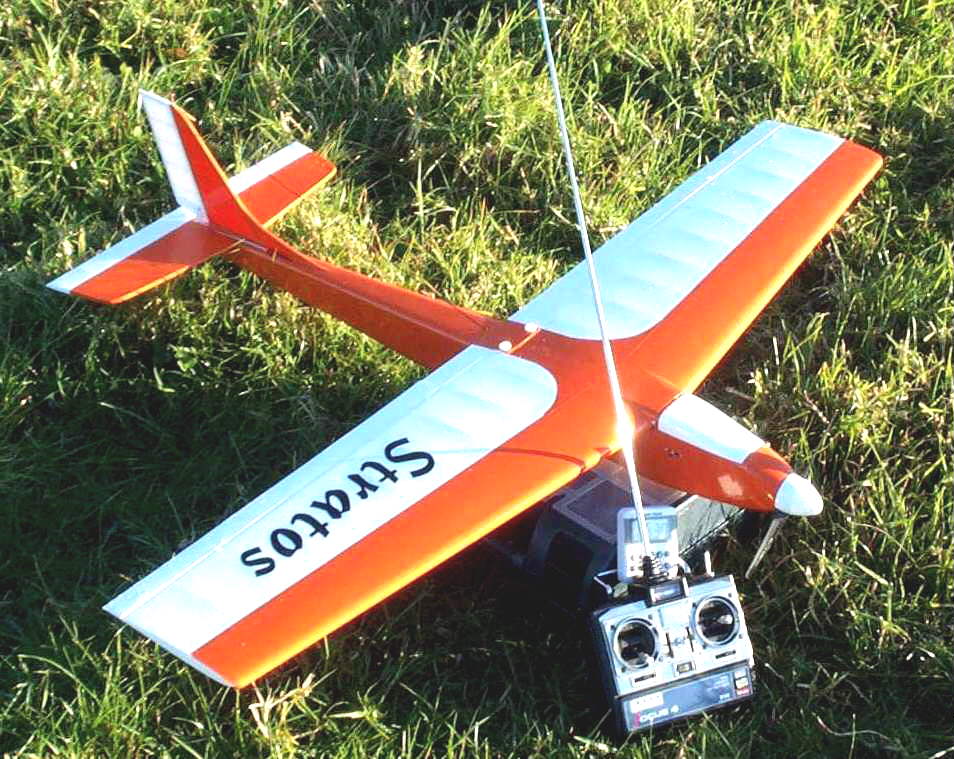

Dear Ken,
 I read Ampeer with great interest each month, and have drawn considerable
inspiration from the models featured and the practical down-to-earth comments made by your contributors. I have attached
photos of two of my recent models. The Stratos is my "own design" based on peering at photos of many others. The
wingspan is 49", wing loading 13.5 oz./sq.ft. and will fly for up to 7 minutes on 7 x SCR1700's, driving an old MFA 15 motor. I read Ampeer with great interest each month, and have drawn considerable
inspiration from the models featured and the practical down-to-earth comments made by your contributors. I have attached
photos of two of my recent models. The Stratos is my "own design" based on peering at photos of many others. The
wingspan is 49", wing loading 13.5 oz./sq.ft. and will fly for up to 7 minutes on 7 x SCR1700's, driving an old MFA 15 motor.
 The twin is a 53" version of Al Eastman's Eastwind, also at 13.5 oz./sq.ft.
wing loading. I have not flown it yet, but I have fitted two Graupner speed 400 4.8V motors, driving 9x4 props through MFA
gearboxes, on 8 x SCR 1250's. We will see how it goes in a week or so when I get the chance to fly it. To keep the weight
down I have omitted the landing gear for now and will hand launch for the first few flights. The twin is a 53" version of Al Eastman's Eastwind, also at 13.5 oz./sq.ft.
wing loading. I have not flown it yet, but I have fitted two Graupner speed 400 4.8V motors, driving 9x4 props through MFA
gearboxes, on 8 x SCR 1250's. We will see how it goes in a week or so when I get the chance to fly it. To keep the weight
down I have omitted the landing gear for now and will hand launch for the first few flights.
 Currently I am drawing plans (pencil and paper, not CAD) of the Cessna C-34. It
was built in 1934 and only 42 were produced. I have decided to scale it to a wingspan of 55", which will give a wing area of
3.6 sq.ft. Currently I am drawing plans (pencil and paper, not CAD) of the Cessna C-34. It
was built in 1934 and only 42 were produced. I have decided to scale it to a wingspan of 55", which will give a wing area of
3.6 sq.ft.
 Since I can built fairly light (I am aiming for a wing loading of 13 oz./sq.ft.), I
intend trying a Kyosho 600E that I have had for quite a while, with an MFA belt reduction drive, on 7 x SCR2000 cells. Do you
know of anyone who has modelled this aircraft? If anybody knows anything useful about this aircraft, I would be grateful to hear
from them. Since I can built fairly light (I am aiming for a wing loading of 13 oz./sq.ft.), I
intend trying a Kyosho 600E that I have had for quite a while, with an MFA belt reduction drive, on 7 x SCR2000 cells. Do you
know of anyone who has modelled this aircraft? If anybody knows anything useful about this aircraft, I would be grateful to hear
from them.
 Keep up the good work. Ampeer is a quality magazine, well worth reading. Keep up the good work. Ampeer is a quality magazine, well worth reading.
Return to "What's In This Issue?"
My Latest Project - New Era III
From: Dick Corby email: altacom@earthlink.net
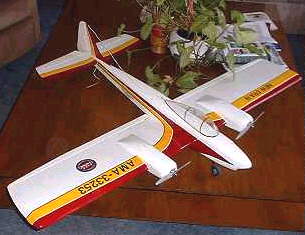
Ken:
 The wing area is 3 sq.ft. so at 48 oz. it comes out to exactly 16 oz./sq.ft. This is a
bit heavy, but not out of line for the design. Should be testing it this week and will advise of results. The wing area is 3 sq.ft. so at 48 oz. it comes out to exactly 16 oz./sq.ft. This is a
bit heavy, but not out of line for the design. Should be testing it this week and will advise of results.
New Era III
 I flew this model with a .25 engine on it back in the 70's. It was a lot of fun, and
performed like a pattern plane until some unfortunate happenstance occurred and it was lost. I don't think the model is kitted any
more, or at least I haven't seen it around. I flew this model with a .25 engine on it back in the 70's. It was a lot of fun, and
performed like a pattern plane until some unfortunate happenstance occurred and it was lost. I don't think the model is kitted any
more, or at least I haven't seen it around.
 I carried the plans around with me for many years, and about a year ago scratch
built the model you see in the picture. I tried every conceivable motor gearbox and prop configuration, and it flew, but was not
satisfactory. To get the power required made it too heavy to perform well. I carried the plans around with me for many years, and about a year ago scratch
built the model you see in the picture. I tried every conceivable motor gearbox and prop configuration, and it flew, but was not
satisfactory. To get the power required made it too heavy to perform well.
 Then it struck me that perhaps adding another engine would overcome the
problems. Hence the twin version. Then it struck me that perhaps adding another engine would overcome the
problems. Hence the twin version.
 It has 2 Magnetic Mayhem motors turning 6/3 props at 10,500 RPM. Uses 7 cells
drawing 29 amps. Weight is 48 oz. Static Thrust is 24 oz. and the motors generate 76 Watts per Lb. This is up from the single
motor version in all categories, and only gained about 6 oz in weight. It has 2 Magnetic Mayhem motors turning 6/3 props at 10,500 RPM. Uses 7 cells
drawing 29 amps. Weight is 48 oz. Static Thrust is 24 oz. and the motors generate 76 Watts per Lb. This is up from the single
motor version in all categories, and only gained about 6 oz in weight.
Return to "What's In This Issue?"
New Speed Controls from Great Planes
From: Heather Rose) email: HROSE@hobbico.com
(Press Release - presented as information only km)
 With high-quality electronics in incredibly small sizes and weights, Great Planes*'
ElectriFly* Electronic Speed Controls are a real boon for fliers of electric aircraft. From the smallest flier, all the way up to
mid-size aerobats, there's an ElectriFly ESC that will upgrade your kit's performance. All offer state-of-the-art smoothness
and come equipped with safety features that protect you and your model. With high-quality electronics in incredibly small sizes and weights, Great Planes*'
ElectriFly* Electronic Speed Controls are a real boon for fliers of electric aircraft. From the smallest flier, all the way up to
mid-size aerobats, there's an ElectriFly ESC that will upgrade your kit's performance. All offer state-of-the-art smoothness
and come equipped with safety features that protect you and your model.
 For very small indoor, park or backyard models with 280 size or smaller motors, the
C-5 Nano* Ultra High Frequency ESC with 5 amp output is the perfect choice. It's extremely compact to simplify installation,
weighs just 0.21 ounces and comes with factory-installed motor connectors. Battery Eliminator Circuitry (BEC) provides
sufficient current for the receiver and two micro servos. The 12 amp C-10 Micro Ultra High Frequency unit is also very small
and lightweight, and designed for planes with motors up to 400 in size, with factory-installed motor connectors and BEC that will
power a receiver and two micro servos. The C-20 Mini High Frequency ESC is ideal for mid-size aircraft with 400 size motors,
as well as some 500-600 size motors. It delivers 22 amps of output, and its BEC will provide current for a receiver and two
standard servos. Other features include an on/off radio switch, thermal shutdown protection and an LED for easy setup. For
mid-size performance aircraft with 400-600 size motors, the C-30 Mini High Power ESC is an excellent option. It has all of the
same benefits of the C-20, along with BEC current for a receiver and three standard servos and a whopping 30 amps of output. For very small indoor, park or backyard models with 280 size or smaller motors, the
C-5 Nano* Ultra High Frequency ESC with 5 amp output is the perfect choice. It's extremely compact to simplify installation,
weighs just 0.21 ounces and comes with factory-installed motor connectors. Battery Eliminator Circuitry (BEC) provides
sufficient current for the receiver and two micro servos. The 12 amp C-10 Micro Ultra High Frequency unit is also very small
and lightweight, and designed for planes with motors up to 400 in size, with factory-installed motor connectors and BEC that will
power a receiver and two micro servos. The C-20 Mini High Frequency ESC is ideal for mid-size aircraft with 400 size motors,
as well as some 500-600 size motors. It delivers 22 amps of output, and its BEC will provide current for a receiver and two
standard servos. Other features include an on/off radio switch, thermal shutdown protection and an LED for easy setup. For
mid-size performance aircraft with 400-600 size motors, the C-30 Mini High Power ESC is an excellent option. It has all of the
same benefits of the C-20, along with BEC current for a receiver and three standard servos and a whopping 30 amps of output.
 All ElectriFly Electronic Speed Controls include fully proportional forward with
brake, with smooth throttle response that eliminates noticeable "steps" and cool, high-frequency operation that
maximizes battery flight times. Safe- Start prevents unintentional motor starts; the low voltage cutoff function reserves control
power for safe landings. All come with factory-installed radio and battery connectors. All ElectriFly Electronic Speed Controls include fully proportional forward with
brake, with smooth throttle response that eliminates noticeable "steps" and cool, high-frequency operation that
maximizes battery flight times. Safe- Start prevents unintentional motor starts; the low voltage cutoff function reserves control
power for safe landings. All come with factory-installed radio and battery connectors.
C-5 Nano* Ultra High Frequency
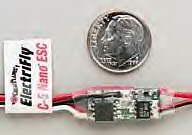
Input: 5-8 cells
Output: 5A continuous max.
Operating Frequency: 3KHz
BEC: 5V/1A
Low Voltage Cut-Off: 3.7V
Dimensions: 0.78 x 0.24 x 0.35 in (20 x 6 x 9mm)
Weight w/Wires: 0.21 oz (6g)
GPMM2000 C-5 Nano* Ultra High Frequency ESC w/BEC $49.99
C-10 Micro Ultra High Frequency
Input: 5-8 cells
Output: 12A continuous max.
Operating Frequency: 3KHz
BEC: 5V/1A
Low Voltage Cut-Off: 3.7V
Dimensions: 0.83 x 0.45 x 0.26 in (21 x 11.5 x 6.5mm)
Weight w/Wires: 0.27 oz (8g)
GPMM2010 C-10 Micro Ultra High Frequency ESC w/BEC 54.99
C-20 Mini High Frequency
Input: 5-8 cells
Output: 22A continuous max.
Operating Frequency: 1.5KHz
BEC: 5V/1A
Low Voltage Cut-Off: 4.8V
Dimensions: 0.95 x 0.65 x 0.35 in (24 x 16.5 x 9mm)
Weight w/Wires: 0.60 oz (17g)
GPMM2020 C-20 Mini High Frequency ESC w/BEC 64.99
C-30 Mini High Power High Frequency
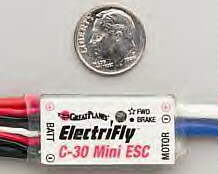
Input: 5-10 cells
Output: 30A continuous max.
Operating Frequency: 1.5KHz
BEC: 5V/1.5A
Low Voltage Cut-Off: 4.8V
Dimensions: 1.30 x 0.69 x 0.37 in (33 x 17.5 x 9.5mm)
Weight w/Wires: 0.70 oz (19.8g)
GPMM2030 C-30 Mini High Power High Frequency ESC w/BEC 69.99
Return to "What's In This Issue?"
Another Mirage 2000
From: Dave Colbert email: davbert55@yahoo.com
 I must concur that the Wattage Mirage 2000 is an excellent flyer. I have
a six volt speed 400, Zagi prop, Hitec 555 receiver, micro Hitec servos, Dean's base loaded antenna, FMA 30 speed control. I
have the limits set to max, no exponential, and the aircraft is a thrill to fly. I must concur that the Wattage Mirage 2000 is an excellent flyer. I have
a six volt speed 400, Zagi prop, Hitec 555 receiver, micro Hitec servos, Dean's base loaded antenna, FMA 30 speed control. I
have the limits set to max, no exponential, and the aircraft is a thrill to fly.
 It is extremely stable hands off. I have had the battery move one inch aft on hand
launches and it still make the field (with some excitement). It is extremely stable hands off. I have had the battery move one inch aft on hand
launches and it still make the field (with some excitement).
 Low passes four feet off the deck are spectacular. Steep climb outs followed by
720 degree rolls to a climbing turn to a dive for a monster loop are what this one evening build is all about. The only concession
I've made to this tiny model is the tape striping to identify top and bottom. Its easy to fly. It is a crowd-pleaser, including fellow
fliers. I answer more questions about this aircraft than anything else I bring to the field. This is truly hero material. Just don't tell
anyone its the easiest aircraft to fly that you brought today. Low passes four feet off the deck are spectacular. Steep climb outs followed by
720 degree rolls to a climbing turn to a dive for a monster loop are what this one evening build is all about. The only concession
I've made to this tiny model is the tape striping to identify top and bottom. Its easy to fly. It is a crowd-pleaser, including fellow
fliers. I answer more questions about this aircraft than anything else I bring to the field. This is truly hero material. Just don't tell
anyone its the easiest aircraft to fly that you brought today.
PS The Zagi prop was installed after the recommended 6.5 prop shook the motor mount loose every third flight.
Performance loss? I don't think so!!
Return to "What's In This Issue?"
News from New Zaeland
From: Lex Davidson email: ldavidson@xtra.co.nz
Hi Ken,
 Thanks for the news. Thanks for the news.
 Is that Peter Haworth from Tasmania--Australia? If it is the same man he got me
what must have been one of the last Ace Cloud Dancer kits. The CD has been done to death, but it is a classic. Did my
conversion much as all the others---great flier- It really would be worth building off the RCM plans (since the kit is hard to find).
Actually you could probably get it lighter that way. Is that Peter Haworth from Tasmania--Australia? If it is the same man he got me
what must have been one of the last Ace Cloud Dancer kits. The CD has been done to death, but it is a classic. Did my
conversion much as all the others---great flier- It really would be worth building off the RCM plans (since the kit is hard to find).
Actually you could probably get it lighter that way.
 For my sins I have been pressed into our National E-SIG (electric special interest
group). Things are boiling alone quite well and for the first time we have a full day of electric competition at our Nationals. 7x7
which is a neat E glider event and F5B. After 3 round of 7x7 and at least 3 rounds of F5B there will be a demo event--yet to be
decided. The other thing the group has done is establish a web page. Cool address--I wouldn't have thought it was available.
www.electricflight.co.nz Not bad. Apart from a local news photos etc. the local
Electric meetings are listed and contact addresses for the committee members. For my sins I have been pressed into our National E-SIG (electric special interest
group). Things are boiling alone quite well and for the first time we have a full day of electric competition at our Nationals. 7x7
which is a neat E glider event and F5B. After 3 round of 7x7 and at least 3 rounds of F5B there will be a demo event--yet to be
decided. The other thing the group has done is establish a web page. Cool address--I wouldn't have thought it was available.
www.electricflight.co.nz Not bad. Apart from a local news photos etc. the local
Electric meetings are listed and contact addresses for the committee members.
 Any of your readers would be made very welcome at these events. The Nationals
are held at the end of the year in one of our wine growing areas. Nearest city is Wellington. It is a bit out of the way (the site
has to cope with CL FAI combat and R/C FAI Pylon the noisiest as well as Free Flight events that need a lot of space). Any of your readers would be made very welcome at these events. The Nationals
are held at the end of the year in one of our wine growing areas. Nearest city is Wellington. It is a bit out of the way (the site
has to cope with CL FAI combat and R/C FAI Pylon the noisiest as well as Free Flight events that need a lot of space).
 For anyone who is coming through Auckland in late February - the last Sunday in
February - we have our own E rally. Feb 2000 was our 1st and was great (reported in Ampeer)- 2001 will be bigger (couldn't be
better) and 2002 will be 2 days (I hope). For anyone who is coming through Auckland in late February - the last Sunday in
February - we have our own E rally. Feb 2000 was our 1st and was great (reported in Ampeer)- 2001 will be bigger (couldn't be
better) and 2002 will be 2 days (I hope).
 We have a neat scheme here for off-shore pilots--Are you ready for this!!! We
have to be responsible - but basically we sign you into the visitors register and you can fly.-- Okay, we will want you to
demonstrate that you know how. But isn't that cool. No insurance hassles, all taken care of by NZMAA, no FAI license
requirements. Just show one of the instructors you know how to check out a model before trying to fly it and then satisfy him
(sorry no hers) you can control the model and land on the strip--WITHOUT smashing anything. Whether flying or not we could
guarantee a relaxing day in the sun with some good yak {talking}and may be a nice bit of NZ beef. We have a neat scheme here for off-shore pilots--Are you ready for this!!! We
have to be responsible - but basically we sign you into the visitors register and you can fly.-- Okay, we will want you to
demonstrate that you know how. But isn't that cool. No insurance hassles, all taken care of by NZMAA, no FAI license
requirements. Just show one of the instructors you know how to check out a model before trying to fly it and then satisfy him
(sorry no hers) you can control the model and land on the strip--WITHOUT smashing anything. Whether flying or not we could
guarantee a relaxing day in the sun with some good yak {talking}and may be a nice bit of NZ beef.
Kind regards, Lex D
Return to "What's In This Issue?"
Pico-Jet
From: Mr. Jean Vautrin, 9916 Fleming Ave, Bethesda MD 20814, Home (301) 493 6983
Email: vautrin@codon.nih.gov
Hi Ken,
 Since I used your advice to end up with the following design, I have to tell you how it is working. Since I used your advice to end up with the following design, I have to tell you how it is working.
 Pico-Jet combat version with Astro 020, 5.5x4 Tornado reverse prop (from New
Creation), 7 2000 mAh NiMH from Ralph Weaver, FMA receiver, 2 FMA S90 servos. (I have not checked the thrust). Total 21
ounces. Great climb, great speed, nice duration, some momentum (inertia) for slow aerobatic but not too much for fast
acceleration and tight turns, and still very pleasant when slowed down 1/3 throttle. The battery is quite in the back, fits tight in
width, and the nose tip is filled with a block of EPP on 2 inches such that the plane should not be too fragile. Pico-Jet combat version with Astro 020, 5.5x4 Tornado reverse prop (from New
Creation), 7 2000 mAh NiMH from Ralph Weaver, FMA receiver, 2 FMA S90 servos. (I have not checked the thrust). Total 21
ounces. Great climb, great speed, nice duration, some momentum (inertia) for slow aerobatic but not too much for fast
acceleration and tight turns, and still very pleasant when slowed down 1/3 throttle. The battery is quite in the back, fits tight in
width, and the nose tip is filled with a block of EPP on 2 inches such that the plane should not be too fragile.
 I used to have an Amptique (my first electric) and I put a 400 on my Zagi before
E-Zagi were available. I rate 5 stars both of these planes. This indicates to me that I agree with the plane rating scale on your
internet site. Consequently I believe, the Pico Jet 020 with 7 2000 NiMH, as well as my IFO with 8 250 NiMH deserve at least 5
stars. I used to have an Amptique (my first electric) and I put a 400 on my Zagi before
E-Zagi were available. I rate 5 stars both of these planes. This indicates to me that I agree with the plane rating scale on your
internet site. Consequently I believe, the Pico Jet 020 with 7 2000 NiMH, as well as my IFO with 8 250 NiMH deserve at least 5
stars.
 Project: I am thinking about upgrading my first Pico Jet 400 (standard foam) with
a more powerful motor (200W at least). Ideal would be that peak thrust exceeds flying weight. Remove the fin and replace it
with two fins extending on either sides of the prop. Adding a horizontal surface between the fins in the middle of the prop flow.
An additional servo buried in the wing would change the incidence of this elevator-like to direct the flux of the prop either up or
down for zapping turns. Your opinion? Project: I am thinking about upgrading my first Pico Jet 400 (standard foam) with
a more powerful motor (200W at least). Ideal would be that peak thrust exceeds flying weight. Remove the fin and replace it
with two fins extending on either sides of the prop. Adding a horizontal surface between the fins in the middle of the prop flow.
An additional servo buried in the wing would change the incidence of this elevator-like to direct the flux of the prop either up or
down for zapping turns. Your opinion?
 (What do you readers think? Send Jean an email or give him a call. KM) (What do you readers think? Send Jean an email or give him a call. KM)
Return to "What's In This Issue?"
News from RBC Kits
Hello Everybody,
 We have a new homepage and a new E-mail address, and we have added new
distributors to our foreign page. We have a new homepage and a new E-mail address, and we have added new
distributors to our foreign page.
 Also added and available is the Paddle, the new crazy park/funflyer, The Paddle
does everything you like, slow to speedy acro or thermal. Also added and available is the Paddle, the new crazy park/funflyer, The Paddle
does everything you like, slow to speedy acro or thermal.
 Unfortunately by various reasons we had to take out 2 models, the Fun 700 and
the T-lizzy. Unfortunately by various reasons we had to take out 2 models, the Fun 700 and
the T-lizzy.
 New models are already on their way New models are already on their way
Rob Bulk
RBCkits
email info@rbckits.com
web www.rbckits.com
Return to "What's In This Issue?"
SR's X-250
From: John Rossetti email: jyuma@pathcom.com
Bramalea, Ontario
 I have been reading the comments on the SR Batteries X-250. I can only say that
mine was built and powered exactly as recommended by Larry Srbnick and mine flies great. My only problem was that I had too
much movement in the controls and my first flight, although successful, was just a bit hairy to say the least. Once I reduced the
control movement it flies like nobody's business. As a relative beginner in electrics it convinced me that electrics are great fliers!
Know anyone looking for some engines? I have been reading the comments on the SR Batteries X-250. I can only say that
mine was built and powered exactly as recommended by Larry Srbnick and mine flies great. My only problem was that I had too
much movement in the controls and my first flight, although successful, was just a bit hairy to say the least. Once I reduced the
control movement it flies like nobody's business. As a relative beginner in electrics it convinced me that electrics are great fliers!
Know anyone looking for some engines?
Return to "What's In This Issue?"
Aircraft rating - Sig LT-25
From: David Platt DPlatt@apu.edu
Aircraft Name: Sig LT-25 laser cut kit
Star Rating: 5
Type of aircraft: trainer
Wing span: 63"
Wing area: 724
Finished Airframe Weight: (less R/C components & power system) 40 oz.
Motor: Astro Flight 15 Geared (normal 2.38:1 ratio)
Battery: 14 2400 mAh Sanyo NiCads
Electronic Speed Controller: Viper 200 1-16 cell 36 amp max. controller
Prop: APC 10x8
Servos: 3 JR 517's
mAh Rating: 4.8V 600 mAh Sanyo flight pack
Finished Aircraft weight; (including R/C components and power system including flight battery) 6 lb.
Comments on construction and flying:
 I love this plane. Built it stock w/ no modifications to the structure and covered in
Solarfilm. Good flyer, hard to stall, even on really *bad* takeoffs. I get easily over 10 minute flights with the 2400 cells. A good
trainer and would recommend it to anyone. I love this plane. Built it stock w/ no modifications to the structure and covered in
Solarfilm. Good flyer, hard to stall, even on really *bad* takeoffs. I get easily over 10 minute flights with the 2400 cells. A good
trainer and would recommend it to anyone.
Return to "What's In This Issue?"
Soldering Batteries
The August issue of the Ampeer lead off with some
information from Charlie White on soldering batteries. If you find it difficult to solder batteries end-to-end or want to learn
Charlie has created a website at: members.home.net/solderingtips/index.html
At the site he demonstrates how simple it really is
to solder batteries end-to-end when you have the correct tools - soldering tips.
Return to "What's In This Issue?"
WING SHEAR WEB CONSTRUCTION
From: Merle Davies mp_davies@yahoo.com
Hi Ken,
I found this article in a old copy of Model Builder
I was reading while resting my back. Took out the important information and set it down below. It believe it would be of interest
to your readers of "La Ampeer" Newsletter. The issue was of 1995, however, the content still has merit. Always enjoy
your newsletter over the many years I have subscribed. The below makes reference to our electric flight pioneer Phil Smith. I
am AWAITING that promised article from him on the method of using fisherman's "Spider Wire" bracing to replace
the wing spar on his 36" "Playboy." He explained process to me at last Mid-America Electric Fly In 2000, and
I made notes and sketches.
WING SHEAR WEB CONSTRUCTION
Shear webbing is used for stiffening the construction of
model aircraft wings. It is common to affix the pieces in a vertical pattern, however, this is not the best for stress movement. Dr.
Michael Selig, sailplane modeler, and professor of Aeronautical Engineering at University of Illinois expresses the following.
"The grain of shear webs should be on the diagonal
from lower inboard to upper outboard of each rib bay, so the compression will follow the wood grain. It is best for shear webs to
take both tension and compression, to take loads on the wing span. Web should be constructed between ribs, and laminated, two
( 2 ) pieces cross grain at 90 degrees, and placed between the spars at 45 degrees. This will require more construction time but
will give the highest strength-to-weight ratio. Light powered models 1/64 balsa plies, and for .40 to .60 powered models 1/32 balsa
plies.....keep the glue weight down."
Phil Smith of Adrian, Michigan uses the following shear
web, as "Flying wires" on a biplane to reinforce the wings. Fishing "Spider Wire" is stretched between
wing ribs to form a " X " between them. Stringing line in both directions is required for normal wing stress, and
inverted flight and landings. On small electric aircraft the wing spar and balsa web is completely eliminated. The wing is
extremely ridged and light, using this construction on a of thirty six inch span "Playboy".
Return to "What's In This Issue?"
E-FLI-OWA Report
From: Jon McVay CD Togflier@aol.com
The second annual E-FLI-OWA held Sept. 9 & 10 is
now history.
The weather looked like it was going to play a big factor
in our weekend as Saturday produced overcast skies and winds from the South/Southwest about 8 to 15 mph with gusts nearing
20. Sunday morning we awoke to pretty strong winds and rain started about 7:30 AM and continued until about 10:00 AM at
which time the general consensus was /LET'S FLY/ which we did until about 3:00 PM. By that time, the winds were really
howling and I decided to wrap things up. The weather had some effect on attendance but all in all I would say it was a successful
weekend.
We had forty-five registered pilots and approximately 150
aircraft ranging from an Albatross to several Zagis. There were several innovative aircraft and some very nice conversions of IC
powered craft including a Sig Somethiní Extra and an Ace Sundancer. I've heard it mentioned that the trend in electrics is
towards smaller models and this was quite evident this year. Scott Christiansen of Sig was on hand and had a prototype of the
new Rascal. What a gorgeous little bird.
E-FLI-OWA is very informal. There are NO competitive
events, no PA system, fly when your pin is available, have a good time type of gathering. Buy, sell, trade or just hang around and
ask questions is the order of the day.
A HUGE thank you to the Davenport R/C Society for
allowing us to use their flying site for the weekend. It's located on a sod farm and is truly an outstanding facility.
Return to "What's In This Issue?"
Grantís X-250
From Grant Calkins CasinoOp@thegrid.net
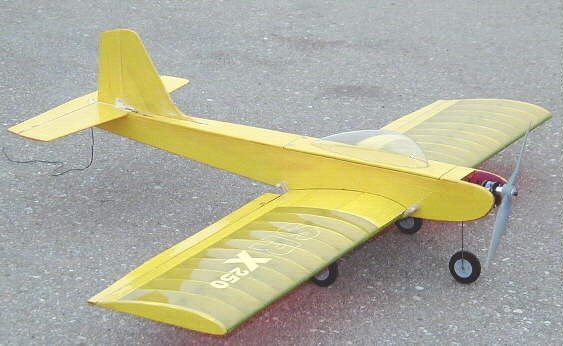
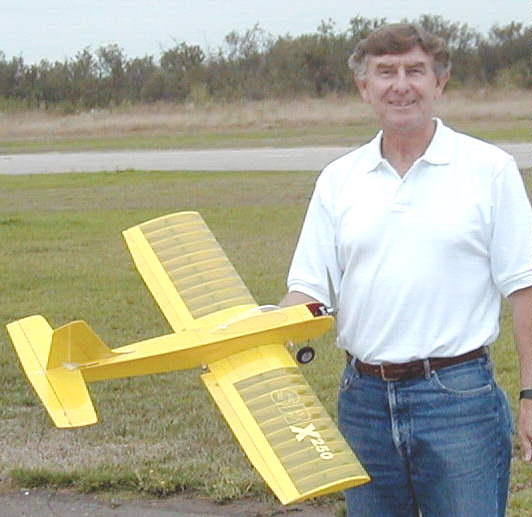
Hi,
On September 11 the birthday boy took the new X-250
plane (SR Batteries kit) to the Condors field for the maiden flight. We tried it last week, but several construction anomalies (read
bad model building) prevented the plane from a meaningful flight. I positioned the craft at the very start of the runway thinking
that it might act under-powered again, but alas not this time! It was off the ground in about 20', and climbed slowly as I dialed in
a little down and right trim. She gained all the altitude I could want as I cut back the throttle and continued to ring it out for trim
and flight characteristics. After more than 5 minutes I eased her in for a pretty good landing (read "still all in one piece and
all parts present") and taxied off the runway. It seems that the battery was barely used and wasn't even warm! Could
have flown over 10 minutes I bet. Attached is a picture of the X-250, and below are the specs as I built it:
motor: 480 geared 2.3:1 (I think) turning 8x5 prop
battery: 7x2000 mAh NiMH (Panasonic) bought from Ralph Weaver. Same wt as 7x1000 Ni-cads!
ESC: Dymond D20 with BEC, built-in power switch, and brake
weight: 29 oz all-up
WS: 36" with 2 graphite spars
wing loading: about 15 oz/sq ft
current draw: unknown at this time
landing gear: tricycle, no steerable nose wheel (rudder steering only - works fine)
colors: Yellow on top, fuse, and tail, red on all bottoms (all transparent FlightKote)
The X-250 is designed to be aerobatic, and it's no-dihedral
low wing configuration prevents it from automatic recovery following a turn. You must fly it into and out of all turns, and adding
a little rudder doesn't help much. I think I will enjoy this plane very much.
(Grant had asked me how I got the 2000 NiMH
cells in, so sent him a picture. He got them in and then replied with the following. KM)
Yep, it's a tight fit all right. But it goes. However, an
8x2000 NiMH pack would not have made it. On second flight the plane flew for 10.5 minutes, and still had plenty of power
after landing. Glad I listened to you about the good results from the 2000 mAh NiMH batteries that Ralph sells.
Return to "What's In This Issue?"
Bloody Mary Aircraft Rating
From: Bernie Hunt blhunt@kiva.net
Greetings Ken,
Having been in model planes over fifty years ago, I thought
to give R/C a try, so I took advantage of Hobby Lobby's sale a few weeks ago - here's the result:
It was an ARF parkflyer called Bloody Mary with span of
38.5" needing only minor airframe assembly but needing all the hardware installed including servo linkages. The motor
supplied was a geared 280 of unknown manufacture with 9.5" prop needing 350 mAh batteries purchased separately.
The finished weight was 15 oz, less than one overweight
according to the box. The manufacturer, Kavan, did an excellent job of fabricating the parts with everything fitting just as it
should - first class - but their instructions were skimpy, just enough to give a lead as to how the hardware was to be installed.
With its red transparent covering, its rather nice looking.
Having no experience with R/C flying, I've had very little
luck keeping the thing in the air - with its high wing tip dihedral, the lightest breeze flips it around and out of control - also it seems
under-powered so that the climb is rather labored. Touted as a beginner's plane, it's not doing too well so far, needing several
repairs.
However, because of my doubtful flying ability I'll give it a
two star rating **.
Return to "What's In This Issue?"
Waco YMF 3 (E)
From: Walter Thyng docwt@worldpath.net
Hi Ken,
You haven't heard from me for a while. Long story
centered on health problems and a sabbatical.
I'll be sending you a photo of my Platt Waco by
snail-mail. It's currently flying on an AF 40 G (straight-cut) with 20 2000's an FX35D ESC and a Graupner 13.5x8 prop. Weight
is 9 lbs. 14 oz. for a wing loading on 950 squares of 24 oz. Covering is Ultracote and matching paint. The pilot is a much
modified Williams Bros. finished to look like a younger you know who.
It took me all season to get up the courage to fly it (I think
the photos will show why). What a waste as it flew almost correction free (2 clicks each elevator and aileron). Take off with
pants from our grass runway was about 75 feet with almost no rudder input needed. Flight speed was very scale like as were all
the maneuvers. Like the full scale Waco loops need a little dive and rolls are somewhat barrel-like. I have not succeeded in
spinning it yet as the stalls are very gentle, resulting in a series of nose bobs with no fall off. Inverted flight is steady, but requires
considerable down elevator. Landings are a dream!
That big round nose and dummy engine really slow it
down. By using high throttle trim and keeping some air moving over the controls it can really be slowed down and still remain
solid. So far all landings have been three point roll outs.
I'm still playing with aileron differential and moving the cg
around.
Also, I'm going to re-motor it with my MaxNeo and 3.33/1
gearbox which will spin a 15/8 prop on 20 cells. I think it will turn a good flying bird into a great one.
I did try one of the new APC 14/7E props, but it just didn't
seem to fly the Waco as well as the Graupner. However, I did not run any rpm or amp numbers.
My dummy engine is made up from PVC pipe parts and
lollipop sticks. It weighs about twice what a Williams would, but cost only 89 cents a cylinder! With the short nose, I needed the
weight anyway.
I'll get on this as soon as possible, but having just come
back from sabbatical and having two new staff members, I'm a bit busy.
Return to "What's In This Issue?"
NEW ELECTRIC RELEASE FROM HOBBICO!
Press Release from HROSE@hobbico.com
ELECTRIC FREE FLIGHT GROWS UP!
With a main wing that spans over 31" and a
fuselage that's 2 feet long, the Swarm* Electric Free Flight airplane from Hobbico* is designed to dominate other free flight
models at the field. But even with its big dimensions, the Swarm is practically flight-ready, right out of the box: the motor and all
electronic components are already installed - even the decals are pre-applied. Simply attach the main wing and tail section, and
you've got the ideal aircraft for getting into high-flying action.
The Swarm is powered by a pre-installed NiCd battery
that recharges in less than a minute, for nearly non-stop fun. A quick battery charger is included, so the only thing left for you to
buy are "C" batteries for the charger. There's even a field card inside with a preflight checklist, to help ensure
successful flights right from the start. And when the other modelers notice the Swarm's size and eye-catching black-and-yellow
trim scheme, they'll want to get their own!
Specifications
Wingspan: 31.5 in (800mm)
Fuselage Length: 24.4 in (620mm)
Includes: 180 electric motor, 3.6V NiCd battery, quick charger
Requires: 6 "C" cell batteries for the charger
Retail HCAA0300 Swarm Electric Free Flight $34.99
Return to "What's In This Issue?"
BMFA Electric Fly
From: Simon Kidd simonkidd@learnfree.co.uk
I have attached some photos from the BMFA electric fly in
earlier this year in the UK for some inspiration as the building season approaches - although there were a lot in the September
Ampeer.


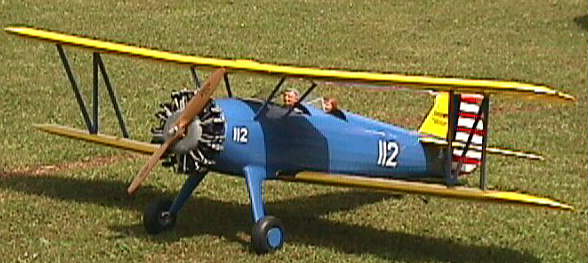
I have also attached some photos of my Grumman Tiger
Cat. It has a 60 inch span, powered by 2 Johnson motors running 12x8 props on 2.1:1 Olympus belt drives in series - 16 cells. It
needs a bit of tuning and is quite heavy for a hand launch but as you can see the first flight was successful and it all came back in
one piece. The wing is balsa covered white foam. The fuselage is a rounded balsa box and the engine pods are white foam on a
balsa profile. It will look better when its properly covered.

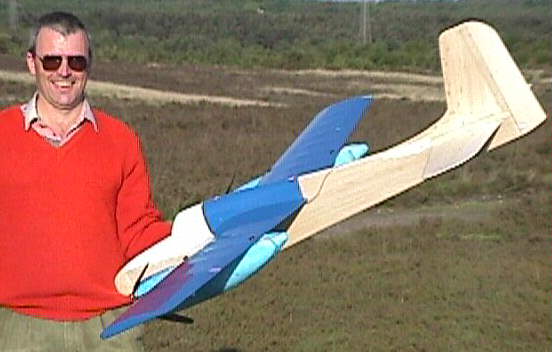
Return to "What's In This Issue?"
Thanks from Joe Hass
August 22, 2000
Dear Keith and Ken:
As I have been for most things this year I am very late in
sending you this note of thanks for putting on the Mid America Electric Fly. Even though I could only attend on Sunday, I had a
great time. Please pass on my thanks to your club members and the Midwest Club members for once again allowing the use of
their field.
Chris and I were both winners in the drawing. Chris won
a gift certificate for Hobby Lobby. After searching through their catalogue he was very disappointed that nothing in electric
airplanes was quite "his style". The latest RC Modeler arrived with a picture of the new SIMPROP SUCHOI SU31.
That was the airplane he wanted!
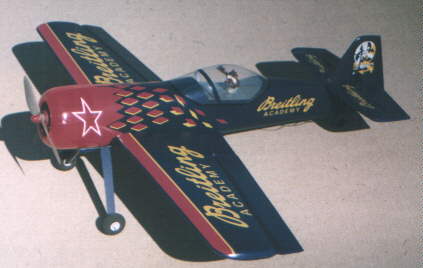
I ordered the kit and the motor/gearbox using his gift
certificate and a few of dadís dollars. Within a few days it arrived and in a few more it was ready (with a few calls to Hobby
Lobby and a few more gray hairs for me). All I can say is WOW! Keith has been to my house so he can appreciate this. I take
off in front of the garage. In about 10 feet itís airborne. I pick up a little speed then go vertical into a hammerhead. I come out
inverted into an outside loop etc., etc., etc. What a blast. Six minutes of fun, and I donít have to leave the driveway, and it looks
like an airplane! Chris quickly realized that it was too much for him, at least for a while, so I get the all the flight duties. Chris did
ask that I replace the pilot that came with the kit with ďTAZĒ. Iím going to do a kit review for RCM. There are a number of
tricks to build it so if anyone is interested have them give me a call.
Thanks for a great event. Thanks for the award. Thanks
for letting us win such great stuff in the drawing.
Sincerely,
Joe Hass
1142 Brunswick Dr.
Rochester Hills, MI 48309
H 248-601-1541
C 248-601-1707
Email: joehass@connect.net
PS: Thank you notes will go out to all the companies that provided items we won.
Return to "What's In This Issue?"
Upcoming October EFO Meeting
The upcoming EFO meeting will be held at the Midwest
R/C Society Flying Field on Saturday, October 7 at 10:00 a.m. It will be our yearly fly-out and all electric fliers in the area are
invited to join us. A field lunch of hot dogs, chips and pop will be provided FREE to all pilots.
Since the August meeting at MISS and the September
meeting at Midwest were lightly attended by EFO members, Iíd sure like to see as many of you as possible at the Fly-out.
Remember that you must have your AMA card with you
to fly at the Midwest field.
Reminder: Sept. 30 Donnelsville, Ohio,
Non-Event: Contact Azarr at photom8kr@earthlink.net The "NonEvent"
concept went over so well last year, we're having another. The club will provide the field for electric flight only. There will be no
events, no demos, no PA system, no concessions, bring whatever you need for the day. All AMA members welcome.
Iíll see you in Donnelsville or at the fly-out. I canít
believe that the flying season is almost over!!!
Return to "What's In This Issue?"
Graupner Buzzard
From: Ray Wellbaum zookpr@worldnet.att.net
I really enjoy reading your newsletter. I have purchased a
Graupner Buzzard ARF Electric Glider from Hobby Lobby International. The kit was missing some of the hardware such as
wing bolts, captive nuts, and control horns. A call to Hobby Lobby disclosed that they have discontinued this product and do not
have the replacement parts. While I do not consider the non-availability of these parts critical, since substitute parts can be found
at my local hobby shop, I felt that your readers should be cautious of encountering this situation in the future. I worry that other
critical replacement parts may not be available in the future.
I also purchased the Graupner GR1717 Geared Speed 600
motor. The recommended battery is a Sanyo 7-cell 1900SRC. However, the specifications with the geared motor (Stating the
same 12-10 prop) show 3.9 minutes of full-power time for 10-cell 1400 mah battery. What battery would you recommend that I
try?
(Follow up email. KM)
Here is a follow up on the e-mail I sent you on August 26.
The replacement parts arrived in the mail today from Hobby Lobby International! I certainly want to make sure that these folks
get the recognition that they deserve.
I am one satisfied customer.
Return to "What's In This Issue?"
EDF Mongo Jr Pictures on the Web
From: Tord tord@natverkstan.net
www.aricraft.com/tord/tord.html
There are pictures of various electric planes at my site, plus
the EDF Mongo Jr, that I now call my Mongojet!
Hope to get my electric flying boat project off the ground
soon ... No pics yet!
Return to "What's In This Issue?"
Lazy Bee Kit Wanted
From: Robert Duncan roadtrip@surf1.de
Looking for a complete-ready to assemble and fly Lazy
Bee kit with around 72'" wing span or larger.
Return to "What's In This Issue?"
What A MONTH!
My new position has really eaten into my flying time, but
Keith and I got to have a day of flying to ourselves. What a joy! Thanks buddy!
Return to "What's In This Issue?"
To Reach Ken Myers, you can land mail to the address at the top of the page. My E-mail
address is:
KMyersEFO@aol.com
EFO WEBsite: http://members.aol.com/KMyersEFO/
|







